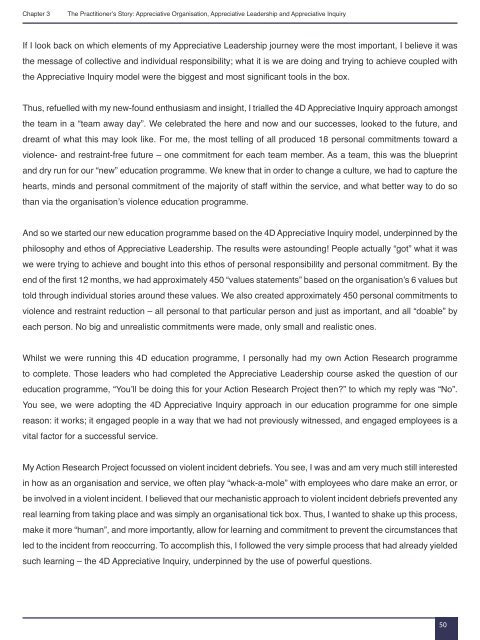Appreciative-Leadership
Appreciative-Leadership
Appreciative-Leadership
Create successful ePaper yourself
Turn your PDF publications into a flip-book with our unique Google optimized e-Paper software.
Chapter 3<br />
The Practitioner’s Story: <strong>Appreciative</strong> Organisation, <strong>Appreciative</strong> <strong>Leadership</strong> and <strong>Appreciative</strong> Inquiry<br />
If I look back on which elements of my <strong>Appreciative</strong> <strong>Leadership</strong> journey were the most important, I believe it was<br />
the message of collective and individual responsibility; what it is we are doing and trying to achieve coupled with<br />
the <strong>Appreciative</strong> Inquiry model were the biggest and most significant tools in the box.<br />
Thus, refuelled with my new-found enthusiasm and insight, I trialled the 4D <strong>Appreciative</strong> Inquiry approach amongst<br />
the team in a “team away day”. We celebrated the here and now and our successes, looked to the future, and<br />
dreamt of what this may look like. For me, the most telling of all produced 18 personal commitments toward a<br />
violence- and restraint-free future – one commitment for each team member. As a team, this was the blueprint<br />
and dry run for our “new” education programme. We knew that in order to change a culture, we had to capture the<br />
hearts, minds and personal commitment of the majority of staff within the service, and what better way to do so<br />
than via the organisation’s violence education programme.<br />
And so we started our new education programme based on the 4D <strong>Appreciative</strong> Inquiry model, underpinned by the<br />
philosophy and ethos of <strong>Appreciative</strong> <strong>Leadership</strong>. The results were astounding! People actually “got” what it was<br />
we were trying to achieve and bought into this ethos of personal responsibility and personal commitment. By the<br />
end of the first 12 months, we had approximately 450 “values statements” based on the organisation’s 6 values but<br />
told through individual stories around these values. We also created approximately 450 personal commitments to<br />
violence and restraint reduction – all personal to that particular person and just as important, and all “doable” by<br />
each person. No big and unrealistic commitments were made, only small and realistic ones.<br />
Whilst we were running this 4D education programme, I personally had my own Action Research programme<br />
to complete. Those leaders who had completed the <strong>Appreciative</strong> <strong>Leadership</strong> course asked the question of our<br />
education programme, “You’ll be doing this for your Action Research Project then” to which my reply was “No”.<br />
You see, we were adopting the 4D <strong>Appreciative</strong> Inquiry approach in our education programme for one simple<br />
reason: it works; it engaged people in a way that we had not previously witnessed, and engaged employees is a<br />
vital factor for a successful service.<br />
My Action Research Project focussed on violent incident debriefs. You see, I was and am very much still interested<br />
in how as an organisation and service, we often play “whack-a-mole” with employees who dare make an error, or<br />
be involved in a violent incident. I believed that our mechanistic approach to violent incident debriefs prevented any<br />
real learning from taking place and was simply an organisational tick box. Thus, I wanted to shake up this process,<br />
make it more “human”, and more importantly, allow for learning and commitment to prevent the circumstances that<br />
led to the incident from reoccurring. To accomplish this, I followed the very simple process that had already yielded<br />
such learning – the 4D <strong>Appreciative</strong> Inquiry, underpinned by the use of powerful questions.<br />
50


